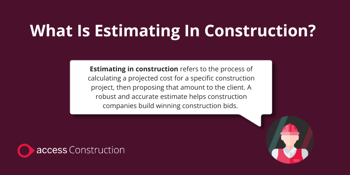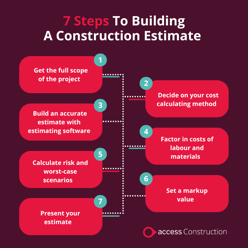How To Estimate Construction Jobs Accurately In 7 Easy Steps
Generating estimates for construction jobs can be a complex process, but there are a few steps you can take to ensure that your estimates are as accurate as possible.
Careful planning and accurate estimates help guarantee that your projects are completed on-time and on-budget, protecting your margins and increasing client satisfaction.
In this article, we break down the art of estimating construction jobs into 7 simple steps.
What Is Estimating In Construction?
A construction estimate refers to the process of calculating a projected cost for a specific construction project, then proposing a total amount to the client. A robust and accurate estimate allows you to bid on projects and keep clients happy.

Why Are Accurate Estimates Important?
You Will Win More Work
An accurate estimate which takes every aspect of a project into account will help you win more tenders and grow your companies’ reputation for quality work, increasing the chance of repeat business.
You Will Avoid Rework
Sometimes error-laden and inaccurate estimates may have to lead to rework later on in the project. An inaccurate estimate can also lead to rework on the estimate itself, delaying a project and eating up time.
You Will Protect Your Profits
Producing an honest and accurate estimate will significantly decrease the risk of losing money later on in your construction project. Building your profits within your estimate and ensuring accuracy will help protect your profit margins.

7 Steps To Estimate A Construction Job
- Get the full scope of the project
- Decide on your cost calculating method
- Use estimating software
- Factor in costs of labour and materials
- Calculate risk and worst-case scenarios
- Set a markup value
- Present your estimate
Step One – Get the full scope of the project
To submit a bid with full transparency, you need details and a realistic idea of what the job entails.
Use your first meeting with the client as a chance to ask relevant questions and address any concerns. Also be honest – let the client know if the project is outside of your capabilities.
Include cost of materials, labour and any other associated costs in your estimate. Your clients need to know whether they can afford your services. By making your estimate as detailed as possible, their expectations are set from the start.
Step Two – Decide on your cost calculating method
There are various methods that you can use to estimate costs. Which method you select is a matter of preference. Your experience, company size or the type of project can influence which method is best for you.
Stick estimating
This involves calculating each individual material unit and hour of labour per unit.
- Pro: provides a more accurate estimate.
- Con: it is a more time consuming process.
- Recommended for: smaller projects.
Hand calculation
This involves manually adding up costs and projected expenses.
- Pro: useful when learning how to estimate at the beginning of an estimating career.
- Con: it is not the most effective estimation process.
- Recommended for: those looking to learn the basics of construction estimates.
Unit Costs
This uses the following formula to determine a projects total cost:
Number of units x cost per unit = total cost of the project
- Pro: quick and efficient method, allowing construction projects to move fast.
- Con: only provides a general approximation.
- Recommended for: experienced construction companies, better when used with an estimating software.
Estimating software
This method offers an easy way to build up a database of construction costs per company.
- Pro: makes generating new project estimates easy.
- Con: many come with extra features that could hinder the estimating process.
- Recommended for: all construction companies that need to offer construction estimates.
Step Three – Use estimating software
Using dedicated estimating software can help construction companies calculate accurate estimates.
An all-in-one estimating software solution will allow you to build accurate Bills of Quantities and manage projects from takeoff to subcontractor bids.
Step Four – Factor in costs of labour and materials
This is arguably the most crucial factor in your construction estimation. Unexpected labour costs can cause major issues in construction projects. Make a list of all the materials required and labour costs associated with the project before work begins. Multiple factors influence materials and labour costs, such as:
- Supply and demand affecting the price and availability of materials
- Inflation and fuel prices
- Unit costs of certain materials
- The cost of purchasing new property or land
- Any legal, administrative or municipal costs
- The costs related hiring subcontractors, such as employee wages and benefits
Step Five – Calculate risks and worst-case scenarios
Unforeseen circumstances often occur during big projects. Think about potential risks associated with the project and factor this into your estimate. For example, labour shortages, safety hazards, bad weather conditions, material cost increases and theft and damage to equipment may drive up the cost of your project.
Step Six – Set a markup value
It’s good practice to add a markup value into your estimate in order for you to make a decent profit on the project. Make sure the amount is appropriate – too low and you risk losing a profit, too high and your client may not want to use your services. To calculate your markup, use this formula:
(Selling Price – Cost to Produce) / Cost to Produce = Markup
There is no need to disclose your markup amount to your client, but it is important to factor it into your estimating process.
Step Seven – Present your estimate
Now it’s time to present your estimate to the client. There are four different types of estimates, which depend on the phase of the process you are in:
- Initial or rough estimate – a first estimate or general overview cost. Often based on industry knowledge and experience. This is not to be stated in a contract.
- Intermediate estimate – this stage is more detailed and helps confirm which of your client’s ideas are workable.
- Preliminary estimate - includes details that are necessary to complete the project, such as budget amounts and financing considerations.
- Final estimate – this is the amount that both you and the client agree to. It should include detailed labour and material costs. An agreement may be signed so that work can commence.
Be sure to answer any questions clients may ask during each of the phases of your estimate. It is important to give full clarity and resolve any discrepancies before construction begins.
Create Accurate Estimates That Win Bids
Access ConQuest is industry-leading construction estimating software which helps estimating teams create accurate estimates quickly. The system includes useful features like automatically lifting measurements from takeoff and a price library of over 10 million items.
Explore our latest estimating software resources
Read our latest content on all things construction estimating software covering key industry questions and trends.






